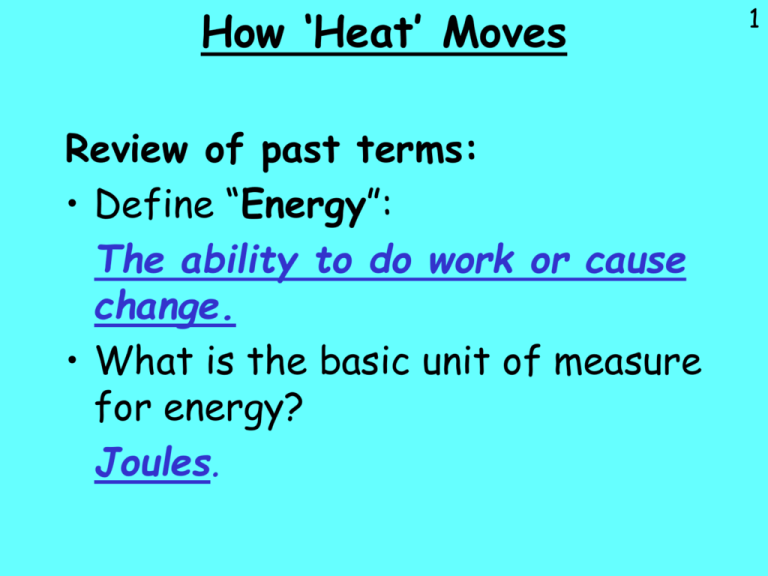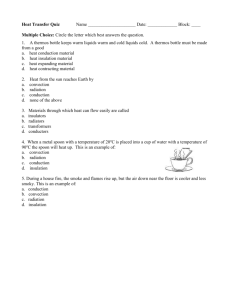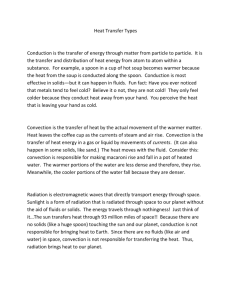Conduction, Convection and Radiation
advertisement

How ‘Heat’ Moves Review of past terms: • Define “Energy”: The ability to do work or cause change. • What is the basic unit of measure for energy? Joules. 1 How ‘Heat’ Moves • Define “Heat”: Heat is the movement of thermal energy from a substance at a higher temperature to another substance at a lower temperature. 2 The Nature of Heat Heat moves in only one direction: • Under normal conditions and in nature, heat energy will ALWAYS flow the warmer object to the cooler object. • Heat energy will flow from one substance to another until the two substances have the same temperature. 3 How ‘Heat’ Moves Thermal energy in the form of heat can move in three ways. Conduction Convection Radiation 4 Conduction CONDUCTION: • The transfer of heat from one particle of matter to another by direct particle to particle contact. – – Conduction occurs primarily in solids because the particles are tightly packed together. The particles themselves DO NOT change positions. 5 Conduction Example: A metal spoon in a pot of water being heated on an electric stove. a. First, the electrical energy is converted to thermal energy by the stove. b. The rapidly vibrating particles of the hot electric coil collide with the particles of the cool pot. c. Heat energy is transferred, causing the particles in the pot to vibrate faster. 6 Conduction d. The rapidly vibrating particles of the pot now collide with the particles of the water at the bottom of the pot. e. The water particles absorb energy and vibrate and flow more rapidly and its temperature increases. f. Now, the energetic (hot) particles of water collide with the particles of the submerged end of the spoon. g. As the particles of the spoon absorb energy and vibrate more rapidly. The temperature of the spoon increases. 7 Conduction h. As the particles at this end of the spoon absorb energy and vibrate faster they collide with other particles in the spoon. As they collide, energy is transferred to the other particles (similar to momentum) and they begin to vibrate more rapidly. i. This process of conduction is repeated all along the metal spoon until the entire metal spoon becomes hot. 8 Conduction Brainstorming: What are other examples of conduction? Application: Describe the process of conduction when you place a hot spoon into a bowl of ice cream. 9 Convection Convection: the transfer of thermal energy (heat) through the bulk movement of matter. – Convection occurs in FLUIDS (liquids and gases). – Convection produces CURRENTS in both gases and liquids. – Thermal Energy heat is carried by the particles as they move from one location to another. 10 Convection Example: Heating water: a. When the water at the bottom of the pot (nearest the burner) is heated, the particles absorb energy by conduction as they touch the hot pot. b. The water particles vibrate more rapidly. c. The particles also move farther apart and the hot water becomes less dense than the surrounding cool water. d. This causes the heated (hot) water to rise. 11 Convection 12 e. The surrounding denser cooler water is forced downward near the burner by the rising hot water. f. This process continues to repeat. g. This FLOW creates a circular motion known as a convection current . Application: How do convection currents form in a room when the heater is turned on? Convection • The warm air from the heater vent will rise. Why?, – • The warm air is less dense than the surrounding cooler air. The cool air is pushed down by the rising warm air. What is the best location for a heat vent in a room and why? Near the ceiling or the floor? Floor: Because the warm air will rise to the ceiling. How about the return vent? 13 Convection Convection currents occur in the environment as well. They produce: – Global winds that contribute to Earth’s weather. – Ocean and lake currents 14 Convection Brainstorming: On a hot summer day the breeze near the beach blows toward the water. However, later in the day the breeze reverses direction and blows toward land and will get increasingly stronger. Why? 15 Convection Answer: In the morning the water may be warmer than the sand causing the air over the water to rise. In the afternoon, the sand has become much hotter than the water and the air above it rises. The air over the water rushes in to fill its void causing a wind. 16 Radiation • Radiation: the transfer of (thermal) energy by electromagnetic waves. – Radiation does not require matter to transfer thermal energy. • All the sun’s energy that reaches Earth travels through millions of kilometers of empty space (a vacuum). – All matter can radiate energy. • You feel the radiation of thermal energy from a bonfire, a heat lamp and a light bulb. 17 Radiation • Other examples of the transfer of heat by Radiation: a. Charcoal grill. b. Hot tin roof. c. Burner on a stove top. d. ? e. ? 18 Radiation Key Point: For radiation to be felt as heat it must first be absorbed by a material. Example: Why do blue jeans feel hotter in the sun than a yellow shirt, even though they are both exposed to the same amount of sunlight? – The blue jean fabric absorbs more radiant energy from the sun than the yellow shirt because of its dark color. 19 Conduction, Convection & Radiation 20 Energy from the Sun 21 Convection, Conduction & Radiation 22 The Nature of Heat What happens when you put ice in a warm soft drink? – The heat energy moves from the soft drink into the ice by conduction (particle to particle contact) causing the ice to melt. 23 Review Describe the three kinds of heat transfer. a. Conduction – transfer of heat energy from one particle to another by direct contact. (Primarily in solids) b. Convection – transfer of heat energy in fluids-gases and liquids) through the bulk movement of matter from one place to another. (Produces currents) c. Radiation – transfer of energy through electromagnetic waves. (Matter is not required!) (Radiant & infrared radiation from the sun) 24 Conduction • Direct contact of particles • Solids/liquids /gases • The handle of a cooking utensil Radiation • Transfer of energy by waves • Only radiant energy that is absorbed becomes thermal energy • Lightbulb • Fireplace Convection • Transfer of energy by bulk movement of matter (fluids) • Currents (wind,water) • Hot air balloon 25 26 Contrast: Conduction Convection Radiation •Direct contact of particles •Solids/liquids/gases •Solids -good conductors •Gases -poor conductors Conduction •Transfer of energy by waves •Only radiant energy that is absorbed becomes thermal energy •Shiny/light colorsreflect •Dull/dark colorsabsorb Radiation •Transfer of energy by bulk movement of matter (fluids) •Currents (wind,water) •Hot air balloon Convection

![Applied Heat Transfer [Opens in New Window]](http://s3.studylib.net/store/data/008526779_1-b12564ed87263f3384d65f395321d919-300x300.png)






